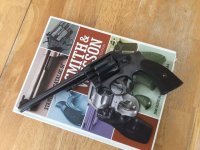I bought this 32-20 two weeks ago.I had ammo on hand
but it was loaded to hot for a gun of this age .
Normally I would of borrowed my brother's rifle and shot
the ammo at targets to get the brass. With the prices of
Powder ,primers and bullets I pulled the bullets out of 100
Of them and saved the components.
I reloaded the primed brass with appropriate load for a black powder age revolver.
I shot the gun from 12 paces (about 10 yards) weather was terrible ,cold and misting rain so I did not mess with bench
And sand bags to test accuracy.
Shot at 5" gong with fresh white paint
on it so it was easy to see hits. First six hit the gong two were
left hand edge hits other four close to center .
Bad news is sights a finer than frog hair.
I bought it because it is a very clean gun in a good woods
caliber but I am going to sell it and look for one with
Heat treated cylinder and betting sights.
but it was loaded to hot for a gun of this age .
Normally I would of borrowed my brother's rifle and shot
the ammo at targets to get the brass. With the prices of
Powder ,primers and bullets I pulled the bullets out of 100
Of them and saved the components.
I reloaded the primed brass with appropriate load for a black powder age revolver.
I shot the gun from 12 paces (about 10 yards) weather was terrible ,cold and misting rain so I did not mess with bench
And sand bags to test accuracy.
Shot at 5" gong with fresh white paint
on it so it was easy to see hits. First six hit the gong two were
left hand edge hits other four close to center .
Bad news is sights a finer than frog hair.
I bought it because it is a very clean gun in a good woods
caliber but I am going to sell it and look for one with
Heat treated cylinder and betting sights.

